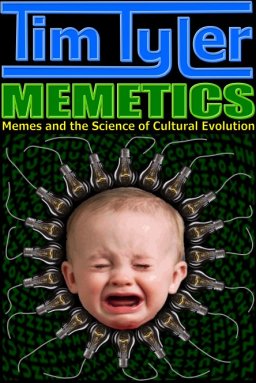 In case anyone needs a recap, August Weismann was the guy who cut the tails off of rats. He concluded that a barrier prevented somatic cells from contribution to evolution - now known as the Weismann barrier. The Weismann barrier is a real phenomenon, but people vary on how permeable they think the Weismann barrier is.
In case anyone needs a recap, August Weismann was the guy who cut the tails off of rats. He concluded that a barrier prevented somatic cells from contribution to evolution - now known as the Weismann barrier. The Weismann barrier is a real phenomenon, but people vary on how permeable they think the Weismann barrier is.There's a corresponding barrier in cultural evolution. Cakes contribute to recipes, but mainly through selection. Anywhere where reverse engineering is complex and difficult, something like the cultural equivalent of the Weismann barrier comes into play. It is hard to dispute the idea that there is less of a barrier in the cultural domain, though. The difference between the domains is partly because there is more reverse engineering in cultural evolution. Genetic engineers can reverse engineer designs originally coded in DNA as well, but for various reasons, they rarely bother. There's plenty of secret computer software in the world, but only a small number of secret genomes. So, people are forced to reverse engineer software from web sites, while few are forced to reverse engineer gene sequences from organic phenotypes.
It's important to recognize that Weismann's barrier is also pretty seriously compromised even if you ignore cultural transmission. As I explained in my article on Lamarckian inheritance in cultural evolution:
Some acquired characteristics are inherited while others are not. If Weismann had chosen a different trait - for example, stress - he might well have drawn the opposite conclusion.
Another problem for Weismann's barrier is genetic engineering. These days a scientist can transfer whatever information they like into the genome. Acquired characteristics, information from somatic cells, detailed sequence information, genes from other species, prime numbers - whatever they like, really. The permeability of Weismann's barrier is increasing as time passes and biotechnology improves.
 Unrelated
symbionts tend to affect the host in similar ways. For example,
many symbionts tend to make hosts leak bodily fluids - through bleeding,
diarrhea, coughing, sneezing and pimples. Similarly, many stimulate interactions
between hosts to facilitate their own reproduction - with rabies, toxoplasmosis
and malaria being some of the best-known examples.
Unrelated
symbionts tend to affect the host in similar ways. For example,
many symbionts tend to make hosts leak bodily fluids - through bleeding,
diarrhea, coughing, sneezing and pimples. Similarly, many stimulate interactions
between hosts to facilitate their own reproduction - with rabies, toxoplasmosis
and malaria being some of the best-known examples. This post is about a topic in symbiology - symbiont restraint of host. The idea applies to both organic and cultural symbionts, so I will attempt a presentation in general terms and then give examples from both domains.
This post is about a topic in symbiology - symbiont restraint of host. The idea applies to both organic and cultural symbionts, so I will attempt a presentation in general terms and then give examples from both domains. The mainstream seems to be finally waking up to some of the idea I expressed in 2008 in
The mainstream seems to be finally waking up to some of the idea I expressed in 2008 in 








